- Producers can break even in as little as two years
- But seed, planting costs challenge economics
- Landowners can frustrate farmers’ cover crop hopes
This is the second part of our four-part series looking at the promise of cover crops and the challenges that farmers face. The first installment, which focused on the management and promotion of cover crops, can be found on Agri-Pulse.com.
Missouri producer Macauley Kincaid started planting cover crops in 2014, primarily for the financial benefits he thought they would provide. It took time, but they paid off.
By 2020, he noticed a 70% reduction in the amount of nitrogen, phosphorus and potassium that he needed to apply to his fields, said Kincaid, who plants cover crops on all of his 650 acres of corn and soybeans.
And even with the reduced fertilizer usage, he’s been averaging 120 bushels of corn the last four years, which is over his county’s trend-adjusted actual production history (APH) for corn at 112 bushels.
“We're over the county average, but our expenses are probably less than half of the average farmer in our area,” said Kincaid, who farms near Jasper in southwest Missouri. “So the cover crops have really saved us a lot of money.”
That’s music to the ears of any farmer who’s considering whether to undertake the practice and all the complexities and challenges cover crops can bring. But the benefits of cover crops — both in terms of soil health and potential profits — don’t appear quickly or uniformly. And some farmers who rent their land may have trouble getting landlords on board.
On average, it takes about three years for producers to break even with cover crops, said Rob Myers, the national liaison on cover crops and soil health for the Sustainable Agriculture Research and Education (SARE) program and the director of the University of Missouri’s Center for Regenerative Agriculture.
In the first year or two, producers may see some of the most apparent benefits, such as reduced erosion and increased weed suppression. However, some of the longer-term benefits, including improved soil health, take longer. By the third year most producers should see the economic benefits offset the costs, and then in the years following, they should return a net profit, Myers says.
“What happens is the yield of the cash crop gradually increases in a modest fashion,” Myers said. “For example, soybeans after three years will be about 3% higher [and] about 5% higher after five years, on average.”
In a 2019-2020 survey conducted by SARE, the Conservation Technology Information Center and the American Seed Trade Association, 58% of 746 responding producers said they began seeing soil benefits to their farm in less than two years of planting cover crops. Additionally, 35% of producers reported a net profit increase of 5% or more after planting them. 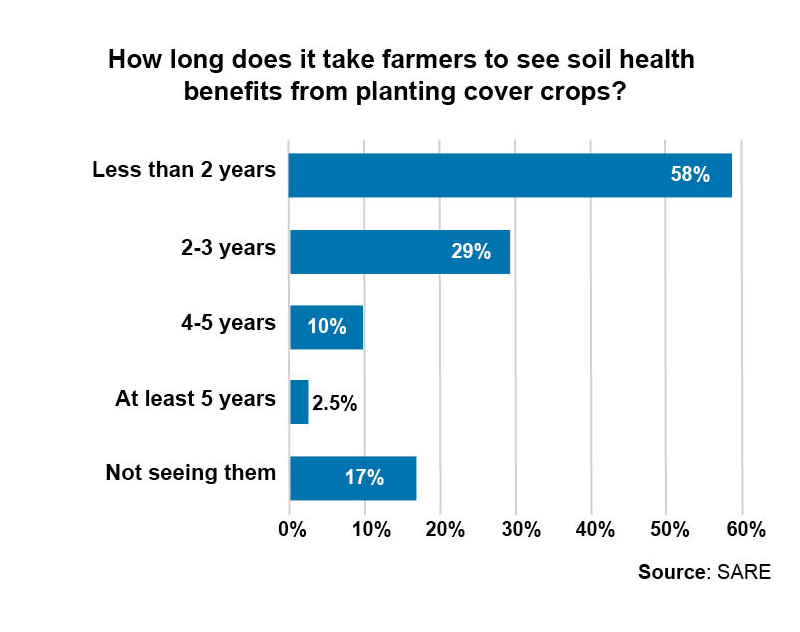
Approximately 29% said it took two to three years to see soil benefits; 10% said it took four to five years. For another 2.5%, it took more than five years. A little more than 23% of producers said they saw their net profits increase 2% to 4% following their use of cover crops.
About 16% of the farmers surveyed, or 125 growers, hadn’t found any soil benefits from growing cover crops. However, 74 of these producers had three years or less of experience with cover crops. About 3% said cover crops had actually cut their net income.
Another farmer who’s seen economic and agronomic benefits within a few years is Matt Ulmer, who grows corn, soybeans and small grains on about 500 acres in central Pennsylvania. He started planting cereal rye as cover 12 years ago when he began farming. He was focused on preventing soil erosion and building overall soil health and resiliency to better cope with extreme weather events.
Ulmer said he’s seen improvements in all of these aspects, but particularly in soil retention, which was a big concern for him.
“Some of the land we have is quite rolling and fairly steep — and fairly sizable plots in some places that are completely on a hillside,” he said. “The cover crop does an amazing job of holding everything there.”
Ulmer says he has “greatly reduced” his fertilizer inputs. He also likes to see six to 12 inches of regrowth in the spring because it helps keep the soil covered and provides some weed relief. But he did note that it may take a while for some producers to see the benefits.
“Sometimes it feels like you’re at it a few years before you start seeing anything,” he said.
In Maryland, the potential for capturing excess nitrogen has encouraged the state government to heavily incentivize farmers for their use. But Ray Weil, a professor of soil science at the University of Maryland, says in order for nitrogen capture to effectively happen, farmers must plant at the right times.
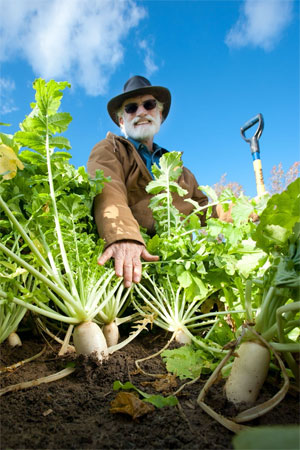 Ray Weil, University of Maryland (Photo: Edwin Remsberg/SARE)
Ray Weil, University of Maryland (Photo: Edwin Remsberg/SARE)
Weil says studies have shown that during the winter, cover crops are dormant and don’t do much to take in excess nitrogen. By seeding cover crops before the end of September — which, for most, would mean interseeding cover crops among still-growing cash crops — producers can get the most nitrogen reduction possible.
“There's a huge difference in the concentration of nitrogen in the drainage water coming out of the fields looking at an early planted cover crop versus no cover crop,” Weil said. “If it's planted very late, you may have a little bit there, but the effect kind of disappears.”
Despite the benefits cover crops can provide, they are still an investment, and it can be hard given the potential trade-offs for producers to take the risk of changing their practices.
“In California we just have very high labor costs. So doing extra operations, we have to be really careful that that's gonna return value,” said sixth-generation specialty crop producer Cannon Michael .
“So, I would say that there's probably more people on the sidelines, trying to figure out if this is going to make economic sense and then also just trying to learn.”
Seed, planting costs figure big in cover crop economics
Cover crops, like any cash crop, are an investment. When planning their rotations, producers factor in the costs of buying seed, planting it and making sure it gets terminated before their next cash crop.
Seeds and planting account for the lion’s share of growing cover crops. Seed expense alone represents about two-thirds of the total cost of planting cover crops, based on an average seed cost of $25 an acre, according to a SARE analysis. Planting expenses accounted for most of the rest. Termination costs can range from nothing to $10 an acre; some cover crops die on their own.
The median cost of seed was actually lower than $25 at $16 to $20 an acre in the 2019-20 survey by SARE, the Conservation Technology Information Center and the American Seed Trade Association. The median in the 2012, 2013 and 2014 surveys was $25 an acre.
Myers said some types of seed, like cereal rye, may have become less expensive per pound because more farmers are growing it for cover crop seed. However, he said seed for clovers and vetches are not likely to be much cheaper than a few years ago.
Radish, winter pea and clover are among the most expensive species, and they are most popular with horticulture producers on small plots of land, the latest survey indicates. About two-thirds of the survey’s 151 horticulture respondents reported paying more than the median range for seed, and about one in four paid more than $40.
A separate study by the USDA Economic Research Service said oat seed planted as a cover crop on cotton, corn and soybean acres cost about $19 to $21. Winter wheat seed cost about $15 to $16.
 Justin Fruechte, a senior forage and cover crop specialist at the South Dakota-based Millborn Seeds, said grains and brassicas are generally the cheapest seed types per acre, while legumes are the most expensive.
Justin Fruechte, a senior forage and cover crop specialist at the South Dakota-based Millborn Seeds, said grains and brassicas are generally the cheapest seed types per acre, while legumes are the most expensive.
When Millborn Seeds designs mixes for South Dakota producers, the company considers issues such as the producer’s goals, how the seeds will be planted, and the distinct nature of the farmers’ soil and climate, Fruechte said.
“We can do a lot of cover crops for around $15 per acre, and as guys want to get more creative or try different things or have more legumes in the mix, then that cost per acre can get more expensive,” he told Agri-Pulse. “But usually it probably peaks at $25 to $30 per acre.”
He’s noticed that many producers in the area tend to like radishes, turnips and rye, and a growing number are planning to use cover crops as livestock feed.
Kent Wasson, a Montana wheat and cattle producer, is in the latter group. He plants a mixture of cowpeas, chickpeas, millet, sorghum, radishes, turnips and an early maturing type of corn to primarily be used as cattle feed.
He had to pay more than $20 an acre for seed this year, but by grazing his cover crops he also cuts back on his feed costs, he said.
Seeding method affects timing, effectiveness
There are a number of different methods for planting cover crops, but when producers choose which route to take, they need to consider timing, effectiveness and cost, experts say.
Cover crops can be “planted green” into standing cash crops or they can be planted after or during harvest. Some of the most common methods include:
- Interseeding: According to extension educators at the University of Nebraska-Lincoln, producers can plant cover crop seed into crops like corn and soybeans, but during periods when the crop’s canopy isn’t closed. Most of the time, interseeding is done early in the season by broadcasting, using a drill or using specialized or modified equipment.
- Overseeding: According to the University of Wisconsin-Madison extension office, cover crops can be planted into standing crops late in the season by broadcasting or by using aerial or highboy equipment. However, Weil with the University of Maryland noted most farmers wouldn’t buy the kind of specialized equipment used to do this. Producers also need to consider the potential of cash crops like corn blocking sunlight or catching seeds before they hit the ground, which can hinder the effectiveness of this approach.
- Manure Slurry Seeding: According to a Purdue University study, producers can mix cover crops with liquid manure inside spreader tanks. Then, they commence with the “shallow injection seed and manure to facilitate the germination and establishment of the cover crop.” The study found the method was an “efficient and effective” method for use in no-till cover cropping systems.
- Post-harvest seeding: Cover crops can also be planted following a cash crop. Most of the time, this is done with a drill, air seeder or using aerial equipment like planes or drones.
- Equipment: Seed drills, air seeders and airplanes all are used by farmers for seeding cover crops, and there are new technologies coming on the scene, including drones.
Of all seeding technologies, no-till or conventional drills are among the most effective at ensuring cover crops are planted fully, although farmers generally have to wait until after the cash crop is harvested to seed their fields. Still, the drills help ensure that the seeds are placed in the ground at the right depth and rate.
Weil, the University of Maryland professor, said no-till drills are very common among farmers in the Northeast.
“It's reliable, you'll get a good stand,” Weil said. “Drilling works, but it means you have to wait until after harvest.”
 However, using a drill often requires more time than other methods, which can be difficult for producers who are more focused on harvesting their cash crops. Additionally, it may be hard for producers to effectively use their window of time for seeding if they are seeing rain or wet conditions.
However, using a drill often requires more time than other methods, which can be difficult for producers who are more focused on harvesting their cash crops. Additionally, it may be hard for producers to effectively use their window of time for seeding if they are seeing rain or wet conditions.
Airseeders, which blow seeds through hoses to the ground, are also commonly used for seeding cover crops. Noah Wendt, who co-owns an Iowa farm with Caleb Akin, has previously seeded using an air seeder mounted on a neighbor’s vertical tillage tool. The airseeder blew seed in front of the tillage tool, which worked it into the ground.
“We got two benefits out of that,” Wendt said. “We got the cover crop seeded and it also tilled the soil.”
Wasson, the Montana wheat producer, has 70-foot air seeders that he uses to plant brassicas. He normally tries to get them at least ¾ to 1 inch deep in the ground.
“We seed it just like we would wheat, only a little bit shallower,” he said.
For producers who need more flexibility, aerial seeding options might be a more appealing choice. Airplanes can drop seeds in a variety of conditions, including when soils are wet after rain or when cash crops are sitting in fields.
According to a 2019 industry survey by the National Agricultural Aviation Association, aerial applicators use planes to seed about 956,000 acres of cover crops every year.
“Probably the number one reason for the popularity for aerial application of cover crops is, it can occur before the cash crop has been harvested,” Scott Bretthauer, the director of education and safety for the National Agricultural Aviation Association, told Agri-Pulse.
The most common airplane hopper size is 500 gallons, though others can range from 200 to 800, depending on the model. One potential challenge can present itself if applicators run out of seeds. To reload, they often need to go back to their airstrip.
However, if the airstrip is located far from the fields they are seeding, seeding will take more time and producers may need to pay extra.
Additionally, some light seeds can catch the wind when being dropped from the air and drift away from the intended location. Others might land on top of large cash crops like corn and never fully reach the ground.
Drones are an emerging technology and like planes, they have been adapted to plant cover crops aerially. They can be completely remote-controlled, but the downside is that they are small and can’t hold very much seed.
Lee Tesdell, an Iowa landowner who has worked with a farmer renting his land to establish cover crops, tried drones this year but found they can only plant about 20 pounds of seed per acre at a time, which means they can’t cover very many acres before needing to be refilled.
“I'm not real optimistic about drones at the rate I'm using them,” Tesdell said. “I want more seed on the ground.”
According to a SARE report, costs for seeding cover crops can range from $5 to $18 per acre, though a 2012 survey found a median cost of $12 an acre.
Hiring an aerial applicator may cost $12 to $18 per acre, while a 10-foot drill may cost around $10 an acre and a 40-foot row crop planter could amount to $10 an acre. If seeding with fertilizer, producers would likely just pay the cost of the fertilizer application and the seed.
Myers said cost-conscious farmers have found ways to reduce their cost of cover crop seeding. For example, some are using more efficient methods of seeding like a 30-foot-wide row crop planter rather than a 10-foot-wide drill. Others are having their fertilizer dealers mix their cover crop seed in with their fertilizer to save an extra trip over the field.
Some 20% to 30% of farmers are using lower seeding rates per acre for cover crops than they used to, either to stretch their dollars, make it easier to plant green, or just because they believe they can get the cover crop they need with less seed, according to Myers.
Don’t miss a beat! It’s easy to sign up for a FREE month of Agri-Pulse news! For the latest on what’s happening in Washington, D.C. and around the country in agriculture, just click here.
Getting that landlord (or renter) on board
Cost isn’t the only factor farmers have to consider: Producers can’t even get to the point of figuring out whether a cover crop will pencil out if they rent their land and the owner doesn’t want cover crops.
In other cases, landowners may want their renters to use cover crops, but can’t convince them to adopt the practice.
More than half of the cropland in the contiguous 48 states is rented.
In the latest SARE survey, 19% of farmers surveyed had concerns about using cover crops on rented land. In the same survey, more than 15% of respondents said they did not own the land they farmed, over 19% owned up to 25% of the land they farmed and just under 8% owned between 26% and 50%.
In Louisiana, where Naveen Adusumilli has been researching the adoption of conservation practices on rented land, there’s an upward trend of farmers using cover crops between the years 1997 and 2020. There’s also a clear increase in tenant-farmed land acres, as more landowning farm operators age and decide to rent out the land instead of continuing to work it. However, as there’s no hard data on the two together, it’s unclear whether there’s a link or not.
“That's the kind of a connection we would like to make,” Adusumilli, an associate professor of agricultural economics and agribusiness at Louisiana State University, told Agri-Pulse. “But hard numbers are tough to report.”
But according to Adusumilli, many of the barriers to cover crop adoption on rented ground tend to present themselves when the landlords aren’t actively engaged in the operation of the farm.
According to USDA, 80% of rented farmland in 2014 was owned by landlords who are not actively involved in farming. And nearly 20% of the acres rented in eight states — Kansas, North Dakota, Oklahoma, Mississippi, Texas, Washington, Idaho and Arkansas — was owned by landlords who lived more than 100 miles away from the land.
It can be difficult for tenant farmers to convince a landowner who is not actively involved in the day-to-day operations of the farm to support the adoption of cover crops on the operation and even more difficult when those landowners live long distances away.
“There is — I wouldn't say an uphill task — but a little bit of a substantive argument that a farmer has to make with these absentee landowners,” Adusumilli told Agri-Pulse. “So that's one of [the barriers], which is, is the farmer an actively-engaged owner or an absentee landowner?”
For instance, according to a study by USDA’s Economic Research Service, states with a higher percentage of absentee landlords had a lower percentage of cropland under cover crops in 2017. However, the report’s authors noted there was no statistical association between the percentage change in cover crop usage over the period studied.
“I think nowadays it's just not so much of that landlord interaction with the growers anymore because a lot of them are either renting through a farm management group or they're living away from the farm,” said Adam Smith, a farmer who rents land in Iowa and also works at Beck’s Seed Co. “So they're not really seeing what's going on.”
Smith said he hasn’t had much of a problem with implementing cover crops on his rented ground, however. He said that the owners take a fairly hands-off approach and let him handle most of the management decisions. 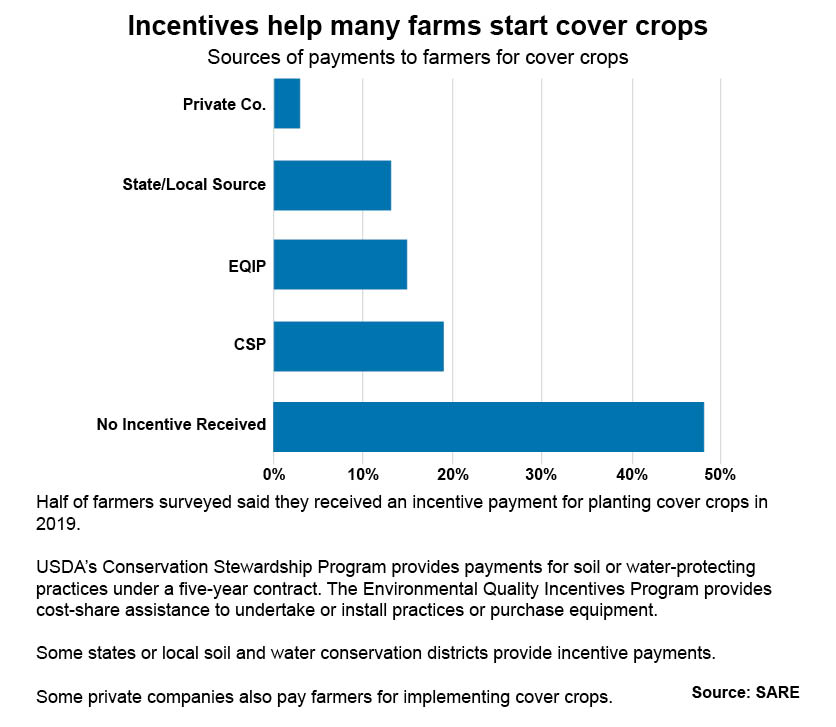
As for landowners who want to implement cover crops on their land, they often must make the initial steps with their renters, said Tesdell, who worked with the farmer renting his Iowa farmland to adopt the practice.
“Tenants are going to be a little reluctant to try new practices on rented ground,” he said. “So the point I like to make with landowners is, step up and take the lead. Get yourself educated about conservation.”
Plus, there’s the question of who pays the cost of cover crops. Most landowners lease out their acreage either through a crop share arrangement, in which case the owner shares in the production costs and profit or loss, or through a fixed annual rent.
Farmers who pay cash rent don't have to share their profits with landowners, but those farmers also have to cover their own costs themselves, including the expense of cover crops.
Smith said that he pays for most of his own cover crop costs on his rented ground. Tesdell, on the other hand, shares the cover crop costs with his renter.
“I think the landowner needs to step up and pay for some initial costs,” Tesdell said.
Perennial cover crops find home in orchards, vineyards
Most of the cover crops that are currently being used in row crop operations are annuals, which means they have to be reseeded every year. But perennials, such as grasses and legumes, are used in orchards and vinyards, and with further research, some experts say they could have a place alongside field crops, too.
In Pacific Northwest orchards, perennial grasses like perennial ryegrass and red fescue have been used as cover crops for decades.
According to David Granatstein, a sustainable agriculture specialist at the Washington State University Center for Sustaining Agriculture and Natural Resources, producers began to see the value of planting grasses between rows of trees in the ‘30s and ‘40s, after they began noticing issues with soil degradation and runoff that bare soils caused.
So, to fix the issues, they began planting grass between rows and in many Washington orchards, the practice stuck.
“Here in Washington, people were already growing this perennial grass," Granatstein said. "They didn't consider it a cover crop in the sense that annual crop farmers do. It was just, they planted it, mowed it a few times a year and that's about all they did. They sort of ignored it.”
The potential benefits of growing perennial cover crops in orchards are similar to the benefits seen nationwide with annual cover crops: improved water infiltration, better soil quality, nitrogen capture and improved management of some pests. Additionally, Granatstein said they cost less than annuals because you only need to seed them once and they will reestablish themselves in the years following.
“Some of the benefits you don't see until several years go by because they're changes in soil quality that take a while to happen and maybe are more subtle to express,” Granatstein said.
One barrier to cover crops does appear in California nut orchards that use large vacuums to harvest the nuts, Granatstein said. If the alleyway only consists of dirt, the dust that is sucked up will blow out of the back of the large vacuum machines. But plants in the alleyway could plug up the vacuum, creating an extra obstacle during the nut harvest.
Another problem for cover crops in orchards is the possibility that they will attract some unwanted pests. Granatstein said nearly all legumes are attractive to voles, a major pest for fruit producers. Legumes also draw concern about lygus bugs and leafhoppers, the latter of which can spread the X-disease (Little Cherry Virus) to cherry, peach, nectarine, almond, plum and chokecherry orchards.
“If you've got legumes in the orchard, the leafhoppers feed on the legume, pick up the diseased organism, fly to the tree, suck on the tree, inject it into the tree, and now you've got problems,” said Granatstein. “So it's really set back any interest in alternatives in terms of the legumes — in fact, in terms of most things.”
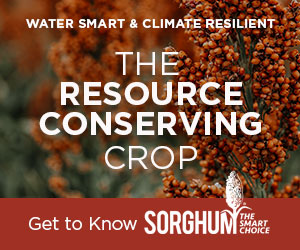 Vineyards are also primary users of perennial cover crops. Patty Skinkis, a professor and viticulture extension specialist at Oregon State University, said it’s common to see perennial ryegrasses and fescues growing in the alleyways between rows of grapes in Oregon.
Vineyards are also primary users of perennial cover crops. Patty Skinkis, a professor and viticulture extension specialist at Oregon State University, said it’s common to see perennial ryegrasses and fescues growing in the alleyways between rows of grapes in Oregon.
“We're on hillsides, so it's a big problem to have a vineyard floor that's not got stability, mainly for the rainy season in the winter,” Skinkis told Agri-Pulse. “So we see that ina lot of the west side of the state, we are growing something, always, in the alley.”
While she couldn’t speak to vineyards in other parts of the U.S., Skinkis said another common cover crop for Oregon vineyards was crimson clover — which seems to grow well in the climate. She said she hasn’t seen very many producers planting just legumes, because grapevines don’t need a lot of nitrogen. The legumes that producers do use are often mixed with grasses.
She also noted that vetches are not very common, because if they are not properly taken care of, they can grow up the grapevines.
Besides their soil health benefits, cover crops can help provide a tourism benefit to vineyards, many of which draw revenue from the people who come to visit each year. To appeal to tourists, grape growers will often plant visually appealing varieties of cover crops near their tasting rooms and wineries, Skinkis said.
“People will grow crimson clover or California poppies — those seem to be the two most common,” she said. “They're easy to seed, very visual in the spring between the vine rows and usually they're mixed with another grass or a cereal grain.”
While they have their uses in orchards and vineyards, perennial cover crops aren’t often planted with annual cash crops like corn or soybeans. Integrating perennial cover crops into an annual system isn’t easy, according to Iowa State University agronomy professor Kenneth Moore.
Moore has been working with several other researchers on perennial ground cover crops for about 15 years and he is convinced that perennial cover crops can work in corn and soybean fields. This approach, he said, can potentially save producers time and money, since they only have to plant the cover crop once.
But if done wrong, perennial cover crops can pose more challenges than they prevent. Using incompatible perennials with corn and soybeans can result in decreased yields, according to one study the researchers conducted. Planting incorrectly or at the wrong time could also have similar effects. In corn, Moore said, it all boils down to a phenomenon called shade avoidance.
If a juvenile corn plant senses competition or is shaded by another plant, that corn plant will alter its growth to avoid it — even if the other plant, a cover crop for instance, doesn’t pose much competition. The result is lower grain yield.
So, the trick behind getting perennial cover crops to work is to find ways to reduce competition, both real or perceived. Moore said the researchers are working on different herbicide and tillage practices to decrease the competition between cover crops and corn. So far, they’ve found that using a strip-tiller to create zones for the corn and some other suppression technologies have helped offset this effect.
At this point in time, Moore believes more research is needed before farmers can start trying to grow perennial cover crops in their corn and soybean fields.
“I call it a brittle system,” Moore said. “It's too brittle for farmers to employ on a large acreage because when it breaks, it can break bad.”
Right now, the best cover crop candidates for use in corn fields appear to be cool-season grasses, which remain relatively dormant when the corn is growing and have one-to-two-inch root systems that won’t go as deep as the corn roots do.
Among the species the researchers have studied are Kentucky bluegrass, which is native to the U.S., and red fescue, a very shade-tolerant farm grass.
Poa balbosa, also known as bulbous bluegrass, also has potential. It is native to Eurasia and North Africa and goes dormant in late March and early April, only to appear again in late September and mid-October. “It goes completely dormant during the summer, I mean, it disappears and you think it's gone and dead forever,” Moore said. “Then in the fall there's just a carpet of green there from it and it's providing excellent coverage to the soil.”
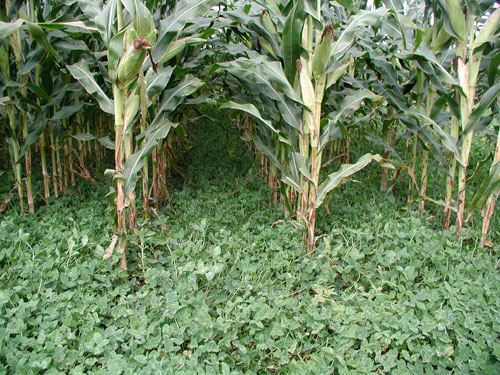 Kura clover (Photo: Ken Albrecht, University of Wisconsin-Madison)
Kura clover (Photo: Ken Albrecht, University of Wisconsin-Madison)
Ken Albrecht, a University of Wisconsin agronomist who has spent the last 25 years doing research on kura clover, says the perennial legume’s deep root system helps it spread and give it greater persistence than other forage legumes. It flourishes in northern climates like Wisconsin, Minnesota, Michigan and the Dakotas.
Research that Albrecht and his students have done on kura clover showed an 80% reduction in soil loss on 6% to 12% slopes. The research also found improved water infiltration and greater earthworm and nightcrawler activity.
But it can be challenging to grow kura clover in a field of corn, and risky to grow it with soybeans.
If kura clover isn’t suppressed and grows more than three inches tall it starts competing with the corn plants. Treating the kura clover with Roundup weedkiller in the spring will help — as long as the corn is glyphosate tolerant — and zone tillage or strip-tillage can be used as well to suppress the cover crop, Albrecht said.
The problem in soybean fields is that both kura clover and soybeans are legumes. That means kura clover can serve as a host for alfalfa mosaic virus. In soybeans, the virus can cause stunting, reduced seed size and reduced pod numbers.
Kura clover can be even more difficult for organic farmers to work with since they can’t use conventional herbicides. Organic farmers can suppress the clover in other ways, including mowing, tilling or burning it with propane equipment, but growers are still likely to see reduced corn yields, Albrecht said.
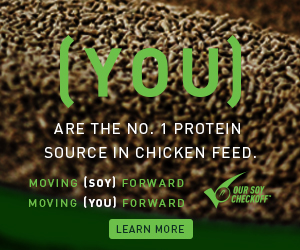 Even with the challenge that perennial cover crops now pose to farmers, Moore, the Iowa State University scientist, is convinced that with more study they can eventually be made to work.
Even with the challenge that perennial cover crops now pose to farmers, Moore, the Iowa State University scientist, is convinced that with more study they can eventually be made to work.
“I think it's an idea that has a lot of merit,” he said. “And I think that there are enough smart people in the agricultural community that can make it work.”
For more news, go to Agri-Pulse.com.
Next: Cover crops can be cash crops, too. Some farmers are starting to make a profit off their cash crops by participating in ecosystem markets, while others are cutting theirs for hay or allowing them to be grazed. And there’s more significant cash cover crops on the horizon, if the airlines and biofuel producers have their way.


